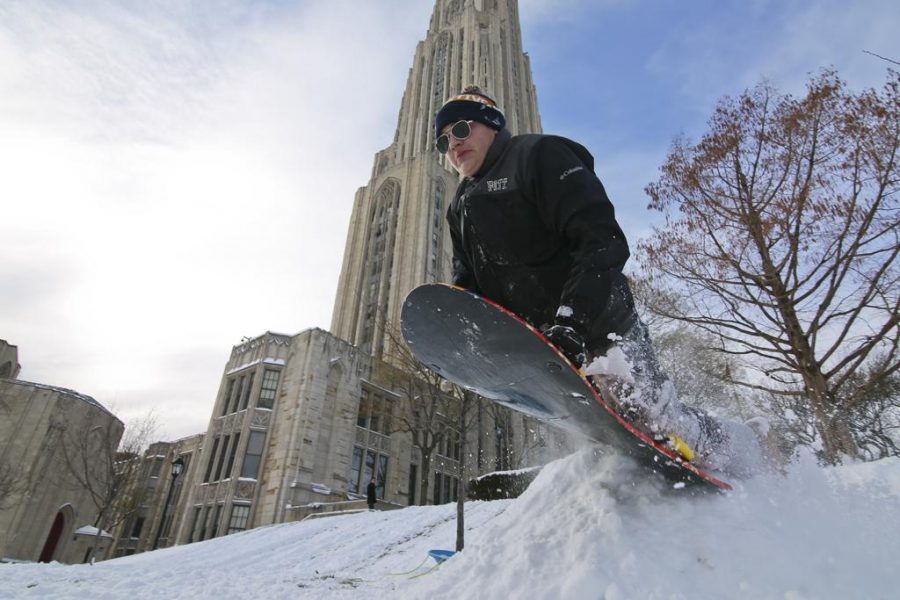Charles Ireland was “frozen” on the Cathedral Lawn this weekend — but not because of the frigid temperatures.
“SOS, medic — I’m frozen,” Ireland cried out for one of his teammates to rescue him in the middle of the snow-covered lawn, playing in a snowball-filled version of capture the flag and tag, called Barrage!
Amid flying snow, victory cries and even a wandering Yeti, 60 people clumsily ran in heavy winter boots to free or freeze each other Saturday afternoon. The frenzy of activity on the Cathedral Lawn resembles Pitt grad Adam Nelson’s experience at the University — though his games have certainly become better organized since he created City of Play as an undergraduate about six years ago.
Nelson’s brainchild, City of Play, is an organization that aims to promote community dialogue and break down social barriers through play-based interaction.
“One of the sad things about living in a city is how little we know each other. We’re all living here together,” said Nelson. “The more opportunities we have to play with each other, the more we can create connections we didn’t realize were there.”
James Lomuscio, a former Pitt student, created Barrage! as a mix between capture the flag, dodgeball and a snowball fight. Players try to steal the other team’s flags while avoiding flying snowballs from other teams.
Once hit with a snowball, the player is frozen until one of their teammates carrying a flag — a “medic” — links arms with them and brings them back to their team’s base.
Katelyn Serago, an undeclared first year, braved the blizzard to come to Barrage! and meet like-minded people.
“I use to have snowball fights all the time back home,” Serago said. “And none of my friends wanted to come, so I figured I’d come meet new people.”
Lomuscio, who left Pitt in 2012 to create an IT startup called Hability, held the first official Barrage! game in February 2011. He first got the idea in 2010, when he saw an impromptu snowball fight on the Cathedral Lawn that inspired him to make it a regular occurrence.
“People loved it,” Lomuscio said. “It was a joyous occasion in the doldrums of winter.”
Nelson met Lomuscio in 2009 when he joined members of Pitt’s outdoors club to play obscure games, such as Circle Rule Football or Human Pinball — a life-size game of pinball played on a hill. Humans function as the walls and springs of a pinball machine to propel a large ball down the hill.
Greg Manley, artistic director of City of Play, created Circle Rule Football as a hybrid between football, rugby, basketball and baseball. Teammates pass a large yoga ball and aim to score at the hoop in the middle of a circular field.
Manley said games that incorporate specific, well-known spots in Pittsburgh create connections between people and places.
“These games make it easier to move between strangers. You do something new in a particular space and you tie a memory to that space,” Manley said.
The games get people moving but also encourage them to reach new depths within themselves and the community, Nelson said.
“Inspiration comes from … recognizing that there are problems that are not solved particularly well [with common solutions],” Nelson said.
The nonprofit hosts two annual events in the spring — the City Spree: 5K and the Come Out and Play Festival, which features obscure games sponsored by businesses. It also hosts smaller activities like Barrage! — team-based games that invite community members to engage with each other and with their city.
Lake Byrd, urban design and development project manager at Hill Community Development Corporation, sought out City of Play to help the Hill District’s efforts to grow small businesses through its Tiny Retail program.
Tiny Retail, which aims to grow economic and community activity in the neighborhood, creates little- to no-cost temporary space in the vacant lots along Center Avenue for training and technical assistance for small business, artists, entrepreneurs, organizations and community groups.
City of Play partnered with Tiny Retail to create Tiny Towers, three obelisk shaped structures throughout the Hill District that serve as a space to facilitate community play and information. On one side of each tower is a low-impact game, like tic-tac-toe. The other side serves as a bulletin board for community messaging. The third side is a chalkboard for community feedback, according to Byrd.
“It’s [an] informative, playful to fit a larger presence,” Byrd said. “Something physical they could respond to as they walk up and down the street.”
As the Barrage! players stomped through the slush, pelting each other with snowballs and dodging flag-stealing attempts, Nelson admitted that it didn’t look like much of a public service from the outside.
“Yes, people playing a game are running around and screaming, but those are the characteristics of people who are truly interacting with each other,” Nelson said.


